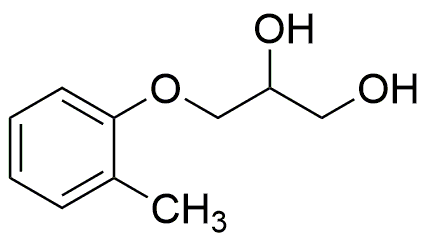Mephenesin is widely utilized in research focused on:
- Muscle Relaxation: Commonly used in the pharmaceutical industry as a muscle relaxant, it helps alleviate muscle spasms and tension, making it beneficial for patients undergoing rehabilitation.
- Analgesic Formulations: Incorporated into pain relief medications, it enhances the efficacy of analgesics, providing better pain management for conditions like back pain or migraines.
- Research on Neuromuscular Disorders: Utilized in studies related to neuromuscular conditions, it aids researchers in understanding muscle function and developing new treatment strategies.
- Cosmetic Applications: Employed in topical formulations for its soothing properties, it helps improve skin texture and reduce irritation, making it a valuable ingredient in skincare products.
- Veterinary Medicine: Used in veterinary formulations to treat muscle spasms in animals, it supports the health and recovery of pets and livestock.
General Information
Properties
Safety and Regulations
Applications
Mephenesin is widely utilized in research focused on:
- Muscle Relaxation: Commonly used in the pharmaceutical industry as a muscle relaxant, it helps alleviate muscle spasms and tension, making it beneficial for patients undergoing rehabilitation.
- Analgesic Formulations: Incorporated into pain relief medications, it enhances the efficacy of analgesics, providing better pain management for conditions like back pain or migraines.
- Research on Neuromuscular Disorders: Utilized in studies related to neuromuscular conditions, it aids researchers in understanding muscle function and developing new treatment strategies.
- Cosmetic Applications: Employed in topical formulations for its soothing properties, it helps improve skin texture and reduce irritation, making it a valuable ingredient in skincare products.
- Veterinary Medicine: Used in veterinary formulations to treat muscle spasms in animals, it supports the health and recovery of pets and livestock.
Documents
Safety Data Sheets (SDS)
The SDS provides comprehensive safety information on handling, storage, and disposal of the product.
Product Specification (PS)
The PS provides a comprehensive breakdown of the product’s properties, including chemical composition, physical state, purity, and storage requirements. It also details acceptable quality ranges and the product's intended applications.
Certificates of Analysis (COA)
Search for Certificates of Analysis (COA) by entering the products Lot Number. Lot and Batch Numbers can be found on a product’s label following the words ‘Lot’ or ‘Batch’.
Número de catálogo
Número de lote/lote
Certificates Of Origin (COO)
This COO confirms the country where the product was manufactured, and also details the materials and components used in it and whether it is derived from natural, synthetic, or other specific sources. This certificate may be required for customs, trade, and regulatory compliance.
Número de catálogo
Número de lote/lote
Safety Data Sheets (SDS)
The SDS provides comprehensive safety information on handling, storage, and disposal of the product.
DownloadProduct Specification (PS)
The PS provides a comprehensive breakdown of the product’s properties, including chemical composition, physical state, purity, and storage requirements. It also details acceptable quality ranges and the product's intended applications.
DownloadCertificates of Analysis (COA)
Search for Certificates of Analysis (COA) by entering the products Lot Number. Lot and Batch Numbers can be found on a product’s label following the words ‘Lot’ or ‘Batch’.
Número de catálogo
Número de lote/lote
Certificates Of Origin (COO)
This COO confirms the country where the product was manufactured, and also details the materials and components used in it and whether it is derived from natural, synthetic, or other specific sources. This certificate may be required for customs, trade, and regulatory compliance.


